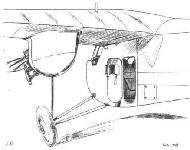
Focke-Wulf GL 18 и GL 22
Первый двухдвигательный самолет конструкции Генриха Фокке, Focke-Wulf GL 18, был создан на базе самолета A 16, получившего носовой обтекатель и два рядных двигателя Junkers L.1a по 78 л.с. (58 кВт), установленных в цилиндрических гондолах под крылом (что придавало им сходство с радиальными двигателями). Первый полет состоялся 9 августа 1926 года и в дальнейшем один самолет использовался авиакомпанией "Deutsch Lufthansa". Вариант GL 18c отличался более широким фюзеляжем и был оснащен двумя радиальными двигателями Siemens Sh.12 по 110 л.с. (82 кВт).
Вариант
GL 22: оснащенный двумя подвешенными под крылом радиальными двигателями Siemens Sh.12, GL 22 был построен в 1927 году и имел ряд других отличий от предшественника, включая более высокий фюзеляж с клинообразной носовой частью и шасси новой конструкции
ТАКТИКО-ТЕХНИЧЕСКИЕ ХАРАКТЕРИСТИКИ
Focke-Wulf GL 22
Тип: легкий учебный/транспортный самолет
Силовая установка: два радиальных двигателя Siemens Sh.12 мощностью по 125 л. с. (93 кВт)
Летные характеристики: максимальная скорость 155 км/ч; потолок 3500 м; дальность полета 900 км
Масса: пустого 1180 кг; максимальная взлетная 1820 кг
Размеры: размах крыла 16,00 м; длина 11,00 м; высота 3,00 м; площадь крыла 32,00 м'
Описание:
- Focke-Wulf GL 18 и GL 22
- Flight, November 1928
BERLIN AERO SHOW 1928
Фотографии
-
Flight 1926-08 / Flight
Один из первых самолетов в серии из семи построенных GL 18/GL 22. Один GL 18 использовался национальным авиаперевозчиком "Lufthansa" в 1926-1928 годах.
A NEW GERMAN COMMERCIAL MACHINE: The Focke-Wulf high-wing monoplane with two air-cooled Junkers engines of 70 h.p. each, has accommodation for pilot and three passengers, and is to be put into regular use on some of the German "feeder lines." The pilot's cockpit is in the nose, where the view forward and downwards is very good. The windscreen slopes up to the leading edge of the wing. -
Aeroplane Monthly 1987-01 / J.Stroud - Wings of Peace
The Gl 18 twin-engined development of the A 16.
-
Flight 1928-11 / Flight
On the twin-engined Focke-Wulf machine the telescopic struts of the undercarriage are taken to the engine mountings on the wing.
- Фотографии


